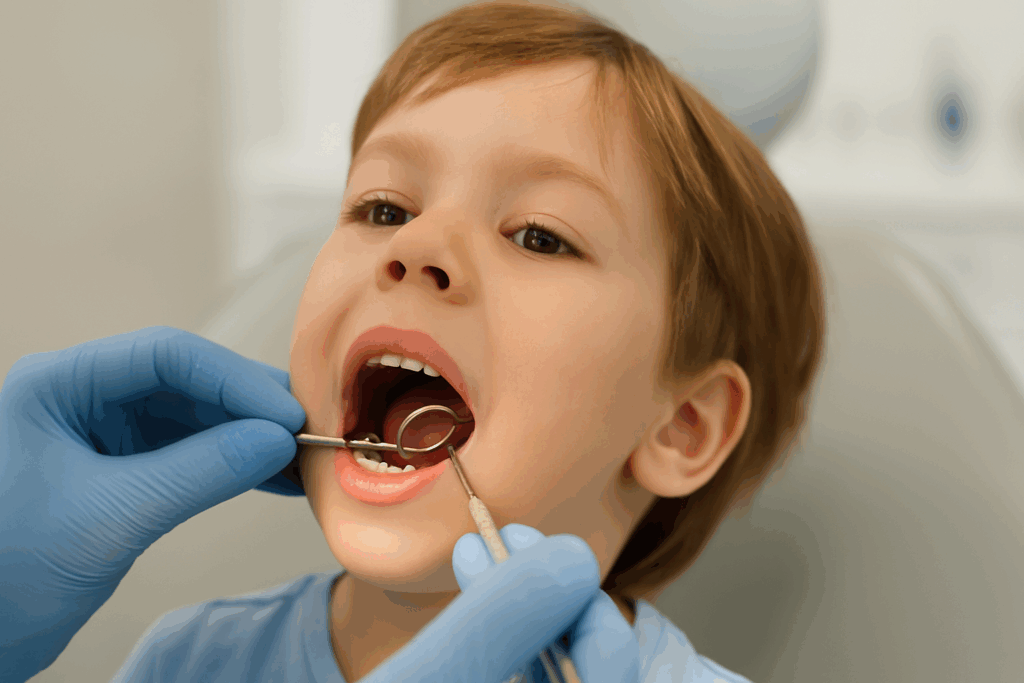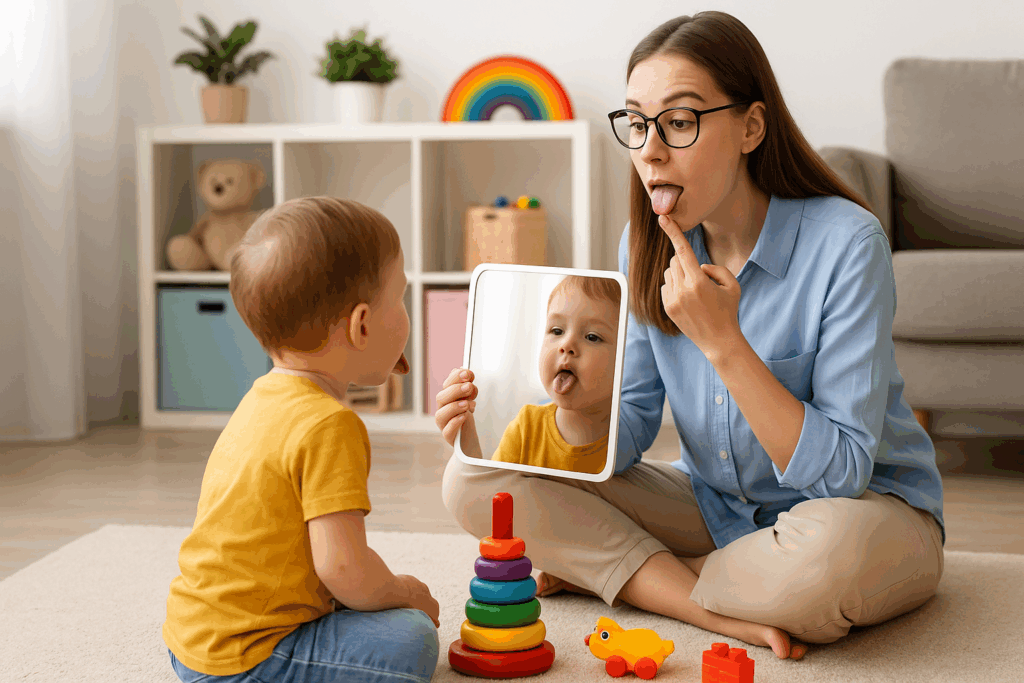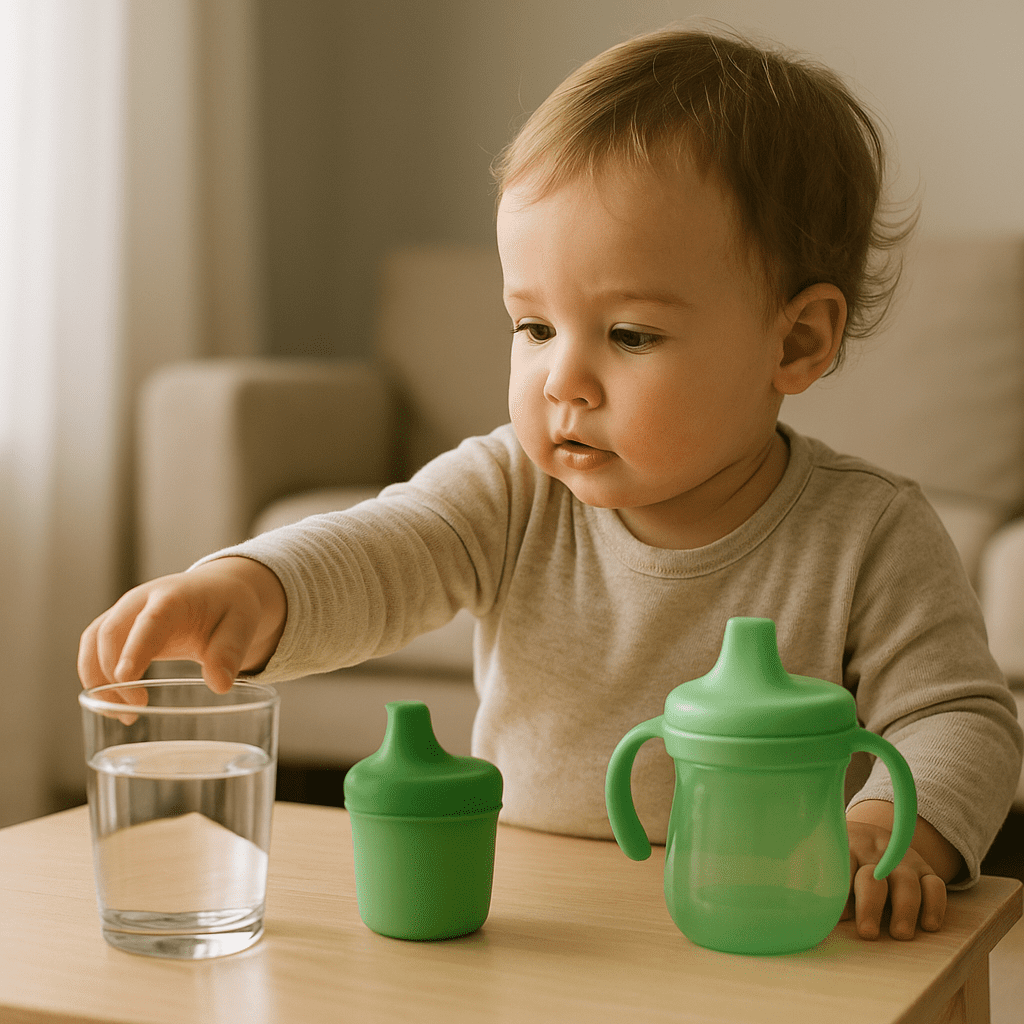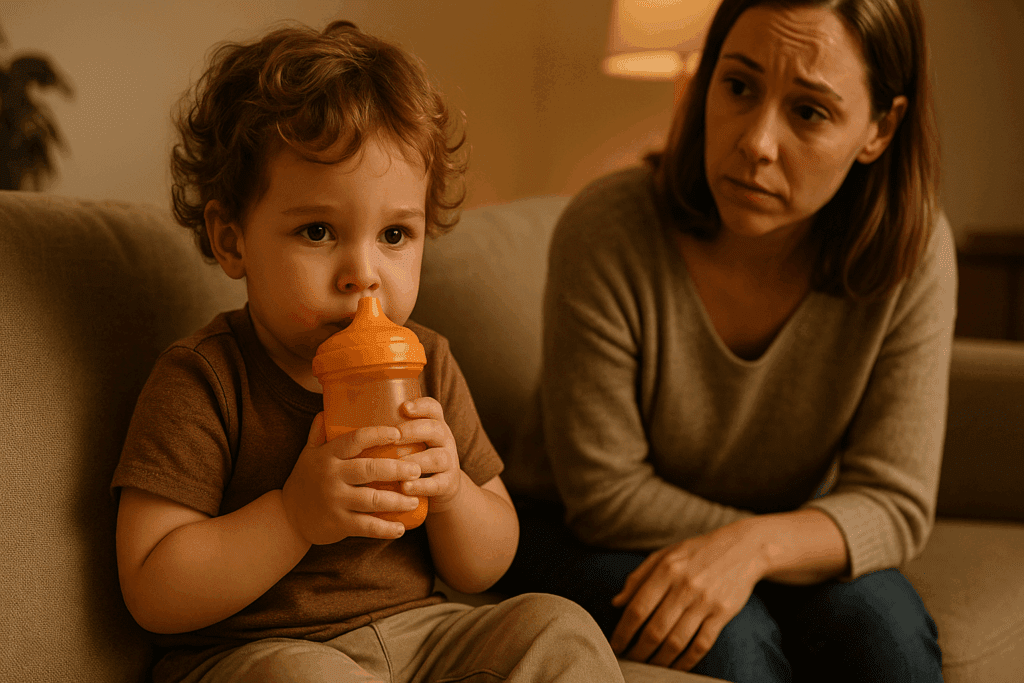When parents look for convenient ways to help their toddlers transition from breastfeeding or bottle-feeding to independent drinking, sippy cups often top the list. Their design seems ideal—a spill-proof lid, easy-to-grip handles, and a gentle learning curve. Yet, growing concerns from pediatricians, speech-language pathologists, and dental experts have raised an important question: are sippy cups bad for young children? This inquiry isn’t just about convenience but touches on vital aspects of early childhood development, including nutrition, dental health, speech, and long-term hydration habits. As caregivers weigh their choices, it’s essential to examine the evidence and understand both the benefits and potential drawbacks of sippy cups.
You may also like: The Ultimate Guide to Choosing the Best Sippy Cup for Healthy Hydration and Growing Kids

Understanding the Rise of Sippy Cups in Modern Parenting
The popularity of sippy cups emerged in the late 20th century as more families sought solutions to manage toddler spills without compromising developmental independence. Marketed as transitional tools, sippy cups promised a bridge between the bottle and the open cup. Their practicality and perceived safety led to widespread adoption. Many parents view them as indispensable in managing the unpredictable chaos of toddlerhood, particularly in public settings or during travel. However, as with many convenience-focused innovations, their unintended consequences have only come under scrutiny with time and longitudinal observation.
The surge in use has been so significant that sippy cup statistics reveal nearly 80% of American toddlers use a sippy cup by the age of two. These numbers underscore how embedded these tools have become in early childhood routines. But behind those figures lies a need to reevaluate whether the benefits truly outweigh the potential developmental trade-offs, especially when better alternatives might exist.

Are Sippy Cups Bad for Kids? Evaluating the Dental Concerns
Among the most vocal critics of prolonged sippy cup use are pediatric dentists. One of the primary concerns is the increased risk of early childhood caries, commonly known as tooth decay. When sugary liquids such as juice or milk sit in the mouth for extended periods, especially when delivered through a spout, they create an ideal environment for bacteria to thrive. Sippy cups, by design, allow toddlers to sip continuously throughout the day, bathing their teeth in sugar without the natural rinsing effects of water or saliva.
Additionally, the rigid spout of traditional sippy cups may affect the positioning of teeth and jaw development. Repeated pressure on the same oral structures can mimic the negative effects of prolonged pacifier or thumb sucking. Over time, this may lead to misalignment, which could require orthodontic intervention. While occasional use of a sippy cup may not result in long-term dental harm, consistent and exclusive use over months or years poses a measurable risk.
Pediatric dental associations increasingly recommend switching to open cups or straw cups as early as possible, ideally by 12 to 18 months. This advice reflects a growing consensus that while sippy cups may be convenient, they are not developmentally necessary and may inadvertently set the stage for preventable dental issues. Considering these risks in the context of a child’s broader oral health trajectory makes it essential for caregivers to use them with caution and clear boundaries.

Speech and Language Development: Another Hidden Risk
In addition to dental concerns, sippy cups are also under scrutiny for their impact on speech and language development. Speech-language pathologists warn that extended use of sippy cups, particularly those with hard spouts, can interfere with the natural development of oral-motor skills. These skills are essential for producing clear speech and involve the coordinated movement of the tongue, lips, jaw, and palate.
During the critical period of language acquisition, typically between ages one and three, children benefit from practicing a full range of oral movements. Drinking from an open cup or a straw requires these muscles to engage in more complex ways than the repetitive sucking associated with sippy cups. When these muscles are underutilized or trained incorrectly, articulation problems may arise later in childhood, potentially necessitating speech therapy.
Moreover, the shape of some sippy cup spouts can encourage a tongue-thrust swallowing pattern. This abnormal pattern, if not corrected, can persist into later childhood and even adolescence, affecting speech clarity and dental alignment. As a result, many therapists recommend parents skip traditional sippy cups altogether in favor of more developmentally appropriate alternatives that support robust oral and speech development.

Sippy Cup Statistics and Their Implications for Pediatric Health
When analyzing the question “are sippy cups bad for kids?” it is crucial to ground the discussion in data. According to recent sippy cup statistics from pediatric health surveys, more than 60% of toddlers use a sippy cup multiple times per day, and nearly 30% continue to use them beyond age three. These figures are concerning when juxtaposed against developmental milestones and health guidelines.
The prevalence of sugary beverages in sippy cups compounds the issue. Studies show that toddlers who use sippy cups frequently are more likely to consume juice and flavored milk than plain water. This shift in hydration patterns can contribute not only to dental decay but also to excess calorie intake, leading to unhealthy weight gain. Nutrition experts emphasize the importance of instilling healthy drinking habits early, as behaviors established in toddlerhood often persist into later childhood and beyond.
The widespread reliance on sippy cups also reflects a cultural shift toward convenience over development. Pediatricians argue that while sippy cups can serve a transitional function for a short time, their overuse may delay important milestones such as learning to drink from an open cup. In this context, the statistics serve as both a snapshot and a call to action, urging parents and healthcare providers to reassess common practices and prioritize long-term health outcomes over short-term ease.

Are Sippy Cups Bad for Long-Term Hydration Habits?
While sippy cups may seem like a harmless stepping stone in a child’s hydration journey, their long-term influence on drinking habits deserves close examination. Unlike open cups, which encourage mindful sipping, sippy cups often promote mindless drinking. A child may carry a sippy cup throughout the day, sipping sporadically without fully recognizing thirst cues or understanding the function of hydration.
This passive drinking style may also discourage water consumption. Since many sippy cups are filled with flavored beverages, children may develop a preference for sweetness, rejecting plain water even when thirsty. Over time, this can skew taste preferences and decrease a child’s willingness to hydrate properly. Additionally, the structure of the sippy cup often restricts fluid flow, meaning that even when children believe they are drinking, they may not be consuming an adequate amount of liquid to meet their hydration needs.
Experts in pediatric nutrition emphasize that hydration is not just about intake volume but also about developing awareness and routine. Teaching children to drink water regularly from an open cup helps instill these habits early, reducing the risk of dehydration or poor beverage choices in later years. While sippy cups may serve as a useful tool during a brief phase of transition, prolonged reliance on them may hinder the cultivation of healthy hydration habits that are critical throughout childhood and adolescence.

The Psychological and Behavioral Impact of Prolonged Use
Beyond the physical implications, prolonged sippy cup use may also shape behavior and emotional development. Some children form strong attachments to their sippy cups, treating them as comfort objects similar to a pacifier or blanket. This attachment can interfere with a child’s ability to self-soothe through more developmentally appropriate methods and may complicate weaning efforts later on.
Behavioral pediatricians have observed that children who use sippy cups well into their preschool years may demonstrate resistance to change, especially when it involves relinquishing a familiar object. This resistance can create power struggles during mealtimes or bedtime routines, which can in turn disrupt family dynamics and place stress on caregivers. Addressing this issue requires a nuanced understanding of the child’s emotional reliance on the object, coupled with gentle yet firm boundary setting.
Furthermore, allowing a child unrestricted access to a sippy cup, particularly during play or while watching television, may reinforce passive consumption behaviors. Rather than encouraging structured mealtime routines, prolonged sippy cup use may lead to grazing patterns that interfere with appetite regulation and nutritional balance. For optimal behavioral development, children benefit from clearly defined eating and drinking routines that support self-regulation and autonomy.
Are Sippy Cups Bad When Used as a Bottle Replacement?
In many households, sippy cups are introduced as a logical successor to the baby bottle. Parents often assume that because sippy cups are marketed as ‘transitional tools,’ they are automatically better than bottles. However, when used as a direct replacement rather than a brief transitional aid, sippy cups may carry similar or even compounded risks.
From a developmental standpoint, the goal is to transition children from sucking to sipping as early as possible. Both bottles and traditional sippy cups reinforce the sucking motion, which limits oral-muscle development. This delay in skill acquisition may set back other milestones, such as speech clarity and feeding competence. While bottles are widely recognized as needing to be phased out by 12 to 18 months, sippy cups often escape the same scrutiny, allowing their use to linger well beyond this window.
Moreover, some parents allow nighttime sippy cup use, particularly with milk, as part of a comfort routine. This habit is particularly concerning for dental health, as it exposes teeth to sugar during periods of reduced saliva production. Pediatricians and dentists now advise that if a sippy cup must be used, it should only contain water and should not be offered in bed. The best path forward involves moving quickly from bottle to open cup, minimizing the use of intermediary tools that may create dependency or hinder developmental progress.
What the Experts Say: Pediatrician and Therapist Perspectives
Across the pediatric healthcare landscape, a growing consensus is emerging regarding the cautious use of sippy cups. The American Academy of Pediatrics (AAP) acknowledges that while sippy cups can be useful for preventing spills and reducing choking risk, they should not be viewed as essential. Instead, the AAP encourages the use of open cups or cups with straws that promote natural oral development.
Speech-language pathologists echo this sentiment, emphasizing that every opportunity to use a child’s oral muscles meaningfully contributes to their speech and feeding skills. Rather than defaulting to sippy cups, therapists advocate for early exposure to open cups under adult supervision, even if it means more spills in the short term. They assert that the developmental benefits far outweigh the inconvenience.
Dental associations similarly highlight the risk of cavities and misalignment associated with prolonged sippy cup use. Their recommendations often include setting a clear limit on usage time, offering only water when a sippy cup is used, and prioritizing alternatives that do not interfere with normal jaw and tooth development. These expert perspectives provide a valuable counterbalance to marketing narratives, helping parents make informed decisions rooted in child health and developmental science.
Are Sippy Cups Bad for Every Child? Situational Use and Individual Needs
It’s important to note that the conversation surrounding sippy cups is not entirely black and white. Some children benefit from the structured transition that sippy cups offer, particularly those with developmental delays, sensory integration challenges, or motor skill deficits. For these children, sippy cups may provide a sense of control and predictability that supports broader developmental goals.
In such cases, the key lies in individualized care. Pediatric occupational therapists often work with families to determine the best drinking tools based on a child’s specific needs and abilities. The decision to use a sippy cup—and for how long—should be grounded in a comprehensive understanding of the child’s unique developmental profile. In this way, sippy cups can serve a constructive role when used intentionally and as part of a broader developmental strategy.
Still, even in special cases, the emphasis remains on progress toward open cup drinking. The tools chosen must serve the child’s growth, not merely offer convenience. Regular re-evaluation of habits, combined with the support of healthcare providers, ensures that parents remain proactive rather than reactive in their approach to hydration and feeding.

Alternatives to Sippy Cups: Exploring Safer, Healthier Options
For parents seeking alternatives, several options exist that support healthy development without the drawbacks associated with traditional sippy cups. Open cups, while messier, offer the most natural path toward functional drinking. Training cups with removable lids or weighted bases can provide some spill protection while still encouraging proper sipping technique.
Straw cups represent another excellent alternative. They require more complex oral-motor coordination, engaging the lips, cheeks, and tongue in ways that mirror speech production. Unlike sippy cups, straw cups do not rely on a sucking motion and are generally less likely to contribute to dental or speech problems. Many straw cups on the market are designed with spill-resistant technology, easing the transition for both children and parents.
Other emerging options include hybrid training cups with silicone spouts that mimic open cup drinking, gradually adjusting the child’s expectations and muscle use. Regardless of the tool chosen, the ultimate goal should be to build skills that translate to open cup competence. With guidance, patience, and consistency, parents can support this transition in a way that aligns with developmental best practices.
Revisiting the Question: Are Sippy Cups Bad in Moderation?
As with many parenting tools, the impact of sippy cups ultimately depends on how they are used. Occasional use in appropriate contexts—such as during travel or in the car—may offer convenience without significant developmental downside. The problem arises when sippy cups become the default, long-term solution for hydration and feeding.
Moderation is key. Parents who use sippy cups sparingly, monitor their contents, and actively work toward transitioning to open cups are unlikely to experience the more serious consequences highlighted in pediatric literature. The challenge lies in maintaining awareness and resisting the pull of convenience when developmental stakes are high.
By framing sippy cup use as a temporary aid rather than a standard practice, caregivers can uphold both practicality and developmental integrity. This balanced perspective empowers families to make informed choices that reflect the needs of their children without compromising on long-term outcomes.
Frequently Asked Questions: Are Sippy Cups Bad for Kids? Uncovering Deeper Insights
How can prolonged sippy cup use affect a child’s social development?
While sippy cups are often viewed through a developmental or dental lens, their impact on social behavior can also be significant. Children who rely heavily on sippy cups may struggle with table manners or group mealtime etiquette when entering preschool settings. Since many early education environments encourage open cup use, children unfamiliar with this standard may feel socially out of sync with peers. This divergence can create subtle stressors, leading to feelings of embarrassment or reluctance to engage during meals. Encouraging open cup use at home not only prepares children for smoother transitions into social eating scenarios but also nurtures a sense of confidence and inclusion among their age group.
What role do caregivers’ habits play in sippy cup overuse?
Caregiver routines and modeling behaviors heavily influence sippy cup dependency. Adults who consistently hand a child a sippy cup to soothe, entertain, or distract may inadvertently reinforce emotional dependency on the object. This pattern can teach children to associate hydration tools with comfort rather than nutrition or thirst. Additionally, busy parents may default to sippy cups as a time-saving solution, missing crucial teaching moments for open cup skills. Mindful modeling—such as drinking water from a glass at meals or discussing hydration intentionally—helps shift the focus from convenience to development, fostering healthier lifelong habits in children.
Are sippy cups bad for sleep routines when used before bedtime?
Introducing sippy cups during evening routines, especially when filled with milk or juice, can compromise both dental health and sleep quality. Sugary liquids consumed just before bed increase the risk of nighttime tooth decay, particularly when saliva production naturally decreases during sleep. Beyond oral health, the act of drinking from a sippy cup in bed can create a reliance on oral stimulation as a sleep aid. This can delay the development of more adaptive self-soothing methods such as reading or relaxation rituals. Transitioning to a bedtime routine that excludes sippy cups supports both better oral hygiene and more autonomous sleep habits.
What do sippy cup statistics suggest about socioeconomic factors in usage?
Recent sippy cup statistics reveal interesting correlations between socioeconomic status and prolonged sippy cup use. Households with limited access to pediatric healthcare or parental education may be more likely to rely on sippy cups beyond the recommended age. This extended use is often due to a lack of guidance or awareness regarding developmental timelines and risks. In contrast, families with access to early childhood specialists tend to wean children from sippy cups earlier. These disparities highlight the need for community outreach and educational resources to ensure that all parents, regardless of background, receive accurate, actionable information about early hydration tools.
Are sippy cups bad when used during screen time?
Using sippy cups during screen time can create a habit of distracted drinking, where children consume liquids without awareness or need. This passive consumption may contribute to overhydration with caloric beverages or underhydration if water is absent. Additionally, the association of drinking with entertainment may blur the lines between thirst and stimulation-seeking behavior. Over time, this could interfere with internal cue recognition, a skill essential for healthy eating and drinking habits. Replacing sippy cups with structured water breaks away from screens helps children develop a clearer relationship with hydration and reduces unnecessary intake.
Can sippy cups delay self-regulation of thirst in toddlers?
Yes, sippy cups may inadvertently delay a child’s ability to recognize and respond to natural thirst cues. The frequent availability of liquids in a portable container encourages sipping out of habit rather than physiological need. This undermines the development of internal awareness and self-regulation, key skills in early nutritional literacy. In contrast, offering water at predictable times and in visible, stationary containers encourages children to link sensation with response. Over time, this supports greater autonomy and a more intuitive relationship with hydration, reducing reliance on external prompts for fluid intake.
How do cultural practices influence perceptions around whether sippy cups are bad?
Perceptions of whether sippy cups are bad for children vary across cultural contexts. In many Western societies, sippy cups are normalized through marketing and convenience-driven parenting trends. However, in cultures where communal eating and open cup use are introduced early, the notion of toddler-specific drinkware is less common. These cultural differences often influence parental expectations and developmental milestones. Observing global practices can help broaden perspectives and encourage more flexible, evidence-based approaches to hydration and feeding strategies in early childhood development.
Are sippy cups bad for children with sensory integration challenges?
For children with sensory processing differences, sippy cups can offer predictable oral input that may be soothing in certain contexts. However, the downside is that over-reliance on the uniform texture and flow of sippy cups might limit exposure to varied oral experiences. This could delay oral desensitization and lead to greater resistance toward textured foods or unfamiliar cups. In therapeutic settings, professionals often incorporate diverse drinking tools to gradually expand sensory tolerance. Families managing sensory challenges can work with occupational therapists to create individualized plans that prioritize development while respecting the child’s sensory profile.
What innovations are emerging to address concerns raised by sippy cup statistics?
In response to growing awareness about the drawbacks highlighted in sippy cup statistics, manufacturers have begun to innovate. New designs include spoutless training cups that mimic open cup drinking while reducing spills, as well as weighted straw cups that encourage proper oral-motor skills. Some companies are also incorporating biofeedback elements, such as color-changing lids that signal hydration reminders, aiming to build awareness and encourage timely drinking. These advancements align with developmental goals while still offering convenience, reflecting a shift in the industry toward evidence-based design. Parents now have access to smarter tools that support both health and ease of use.
How can families transition away from sippy cups without resistance?
Successfully moving away from sippy cups often involves gradual exposure, positive reinforcement, and clear routines. Rather than eliminating sippy cups abruptly, caregivers can introduce open cups during supervised meals while reserving sippy cups for less critical moments. Letting children choose their own open cups—perhaps featuring favorite colors or characters—can increase engagement. Celebrating milestones, such as finishing a drink without spills, reinforces the child’s sense of accomplishment. When framed as a developmental “next step” rather than a loss, the transition becomes an empowering experience that builds autonomy and strengthens parent-child cooperation.
Conclusion: Final Thoughts: Rethinking Early Hydration for Growing Kids
The question “are sippy cups bad for kids?” invites a deeper reflection on how early habits shape lifelong health. While these tools may offer short-term convenience, the evidence clearly signals that prolonged or inappropriate use can hinder oral development, speech clarity, dental health, and proper hydration patterns. Sippy cup statistics further underscore the urgency of this conversation, revealing widespread use that often extends beyond recommended limits.
In rethinking early hydration strategies, caregivers must consider the broader developmental picture. Encouraging open cup use from an early age, offering water instead of sugary drinks, and fostering intentional drinking habits can profoundly influence a child’s well-being. When supported by pediatricians, therapists, and nutritionists, parents can navigate this transition with confidence and clarity.
Ultimately, the path to healthy hydration in childhood doesn’t rely on any single tool but rather on thoughtful choices that prioritize development over ease. By recognizing the limitations of sippy cups and embracing healthier alternatives, families can set the stage for a lifetime of strong habits, confident skills, and optimal nutrition.
Further Reading:
Are Sippy Cups Bad For Kids? Experts Weigh In.
Sippy Cups: 3 Reasons to Skip Them and What to Offer Instead



